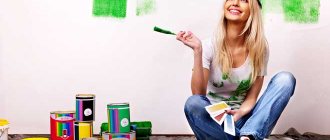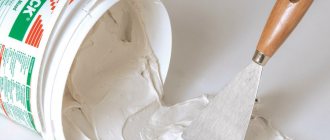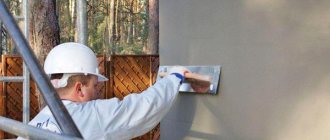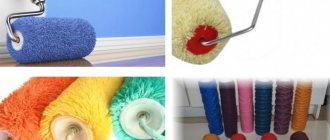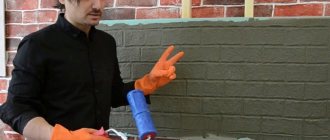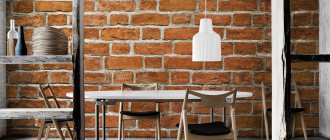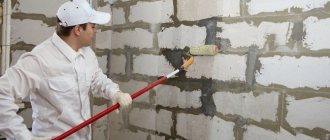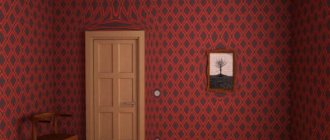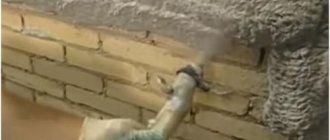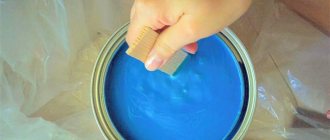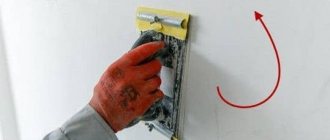When creating an original interior in a residential or office space, experts pay special attention to decorating wall coverings. In their work, craftsmen use a large number of various tools and techniques. Among the variety of techniques, textured rollers stand out, the use of which occupies one of the leading positions.
Textured and structural rollers - what they are, features of their use
The device consists of a rotating cylinder on a curved handle with a variety of coatings that create artistic elements. The textured roller imprints a three-dimensional pattern on the newly applied plaster layer. For example, this way you can imitate brickwork or, using a variety with fur, create an aesthetic roughness. A structural roller is used to apply repeating decor with paint on a dry surface; working with this technique may seem more difficult due to the fact that you need to avoid smudges, but it is easy to learn. This technique is used to decorate wood and fabric.
The textured roller imprints a three-dimensional pattern on the newly applied plaster layer.
Using a decorative roller for plaster
The work begins by applying a layer of plaster to the wall with a thickness of at least 5 mm. This can be gypsum or cement plaster, or tile adhesive. It is easiest to work with glue: it dries longer and has a fine fraction in its composition, which makes the surface quite smooth. Gypsum plaster is good, but it dries much faster and this must be kept in mind. It is better to start work from the top of the wall.
If you are making an imitation of brickwork, then when the plaster is applied, the roller must be pressed against the wall and held horizontally. It is very important to lay the first row as evenly as possible so that the masonry looks straight. To make it easier to apply the first row, you can pull a cord or thread as a guide. Next, the roller is inserted into the bottom trace of the first row and the second row is drawn. The entire wall is decorated in the same way.
To obtain bricks with rounded edges and cracks on the surface, use thin polyethylene film.
If decorative plaster is being applied to the wall, the roller movements are performed randomly. The main thing is to completely cover the wall with uniform decor. To make the texture more uniform, you can roll the roller several times over one place, adjusting the pattern.
To make brickwork or decorative finishing with a roller, the tool must be periodically sprayed with a soapy solution from a spray bottle. This will prevent the solution from sticking to the roller. After the plaster has dried, the wall can be painted any color. The easiest way to do this is with an electric spray gun.
Classification of decorative rollers by pattern texture
Rollers for decorative plaster can recreate almost any motif. Thus, they are used to imitate marble or other stone, brick, wood, textiles, and sand. The thicker the layer of plaster coating and the deeper the coil is pressed, the more voluminous the pattern is.
There are more tricky patterns:
- Waves;
- Braids;
- Shells;
- Ferns and dried flowers;
- Birch bark.
In addition to all kinds of forms presented in stores, the designer can develop a stencil to create an exclusive ornament on a single object, or even several.
Rollers for decorative plaster can recreate almost any motif.
Painting with a texture roller is like creating your own wallpaper design. Typically, floral or abstract themes are chosen, but, if desired, images of birds, waves, and leaf veins can be applied.
Also, tools come in different widths; the wider, the process goes faster there, but narrow ones allow you to repeat the pattern in stripes and provide a clear depiction of small details.
Painting with a texture roller is like creating your own wallpaper design.
Textured roller for decorative plaster
The principle of making a decorative roller for walls with your own hands is similar to the method described above for making a roller for brickwork from silicone. The work is carried out in the same sequence, only the pattern and relief on the roller is created not to resemble a brick, but to match other decorative surfaces.
In our example, this is a monolith stone, tree bark, crocodile skin and stripes. How to quickly make a roller for interesting decorative plaster with your own hands is described in detail in the video.
If you still don’t like making a decorative roller yourself, don’t worry. You can always buy yourself a factory version. The price starts from 700 rubles, but the quality and design of the product are “top notch”!
Materials for making decorative rollers
The production of rollers with patterns from all kinds of materials opens up enormous possibilities for flights of fancy. By type of stamps, almost everything is used. What varieties can be found in construction stores:
Rubber or silicone
They are the ones most often purchased to create three-dimensional ornaments. The price for them is approximately twice as high as for all the others, but as you proceed, it becomes clear why. Patterned rollers intended for coloring compositions are called rigid decorative ones.
They are the ones most often purchased to create three-dimensional ornaments.
Foam rubber
Foam rubber usually has deep pores, the spongy structure allows you to create a mark that looks like tiny craters. The plaster should not contain large fractions or solvents, otherwise the desired effect cannot be achieved, and aggressive substances will destroy the structure, then fragments of foam rubber will remain in the most visible place. Embossed polka dots do not create the expected imprint due to their softness. To treat a large area, purchase several pieces.
Foam rubber usually has deep pores, the spongy structure allows you to create a mark that looks like tiny craters.
Foam
Inexpensive. Disadvantage: it quickly fails, the embossing is flattened, and does not come out at all as expected. You need to buy more and be on guard all the time.
It quickly fails, the embossing is flattened and does not come out at all as expected. You need to buy more and be on guard all the time.
Leather
Leather is used for Venetian techniques, it can form a beautiful marble relief. It is important to choose a natural material of high quality; artificial analogues can slide without giving any result or quickly fail.
Leather is used for the Venetian technique, it can form a beautiful marble relief.
Wooden
Mixtures do not stick to wood, so it is suitable for those who are taking up creativity for the first time. It does not react with chemicals, but does not last long, as it absorbs moisture and delaminates.
Mixtures do not stick to wood, so it is suitable for those who are taking up creativity for the first time.
Plastic
A budget option, they become deformed and crack during use. They are suitable for decorating a small area with an ornament, but it is unclear how the plastic will react to the composition of solutions and paints.
A budget option, they become deformed and crack during use.
fleecy
Made from a variety of materials. Natural fur does not mix well with lime in solutions. Artificial - has a good distribution, but a short-lived coat. Polyamide ones are selected according to the length of the pile, they can be cleaned and can serve for quite a long time. Velor ones leave a barely noticeable mark. The longer the pile, the more textured the effect. At the finish, the same rollers are used to paint walls with a textured pattern.
Low-quality products often fall apart right on store shelves. It is better to immediately refuse the purchase, since it will be impossible to remove lint and pieces of foam rubber from the plaster.
The longer the pile, the more textured the effect.
Decorative rollers
invites everyone to buy decorative rollers for various purposes, wholesale and retail, at reasonable prices.
In our catalog you will find a wide selection of rollers for working with coatings of any texture and complexity.
An interesting texture can be obtained using other tools and techniques, for example, applying chaotic strokes with a narrow spatula, but it is faster and more convenient to work with a roller.
Our assortment includes embossed decorative rollers with a hard rubber coat, which allow you to create beautiful intricate patterns on textured plaster.
You can also buy a cushion roller from us, which is very convenient to use for decorative wall decoration if you need to get an even and smooth coating without strokes. In this case, the paint must be applied in parallel strips, overlapping each other along the length.
If, on the contrary, you want something more unusual, you can buy a decorative roller with a pattern. As a result, you will get a voluminous surface with an elegant three-dimensional pattern.
Are you wondering where to buy a decorative roller? Contact INSTRUMENT DECOR!
New STMDECOR decorative hard rubber roller SUNFLOWERS MINI with stand EL005A(010Y)
RUR 1,800
New STMDECOR decorative hard rubber roller DAMASCUS MINI with stand EL005A(038Y) 1 800
rub.
New STMDECOR decorative hard rubber roller ORNAMENT with stand EL005A(071Y) 1 800
rub.
New STMDECOR decorative hard rubber roller BIRDFOLD WITH CHAMOMILE with stand EL005A(084Y) 1 800
rub.
New STMDECOR decorative hard rubber roller CURLS WITH FLOWERS SMALL with stand EL005A(092Y) 1 800
rub.
New STMDECOR decorative hard rubber roller ROSE with stand EL005A(099Y) 1 800
rub.
STMDECOR decorative hard rubber roller Venetian stone 2203TS 1 000
rub.
New STMDECOR Decorative Hard Rubber Roller Sand Wall 2201TS 1 000
rub.
New STMDECOR decorative hard rubber roller Knitting 2202TS 1 000
rub.
NewHit selling STMDECOR decorative hard rubber roller BRICK LOFT2 EG2207TS 1 500
rub.
NewHit selling STMDECOR decorative hard rubber roller Herringbone EG2208TS 1 500
rub.
New STMDECOR decorative hard rubber roller BRICK CLASSIC EG724T 2 000
rub.
New STMDECOR decorative hard rubber roller PRAGUE YARD EG725T 2 000
rub.
New STMDECOR decorative hard rubber roller OLD LOCK EG726T 2 000
rub.
New Hot selling STMDECOR decorative hard rubber roller BRICK WIDE EG727T 2 000
rub.
New STMDECOR decorative hard rubber roller Oak Bark 2204TS 1 000
rub.
STMDECOR decorative hard rubber roller Paving stones 2205TS 1 000
rub.
STMDECOR decorative hard rubber roller BRICK FLAT EG191T 750
rub.
New STMDECOR decorative hard rubber roller Birch bark EG040T 750
rub.
New STMDECOR decorative hard rubber roller Pine Bark EG045T 750
rub.
New STMDECOR decorative hard rubber roller Poplar Bark EG097T 750
rub.
STMDECOR decorative roller with hard porous texture WT701B 1 250
rub.
STMDECOR decorative porous roller pea EG004T 1 350
rub.
STMDECOR decorative roller with rough porous texture WT13C 990
rub.
STMDECOR decorative woven foam roller 804 1 000
rub.
STMDECOR decorative roller made of twisted velor 801 900
rub.
Best selling STMDECOR decorative leather roller 701 1 900
rub.
MAKO effect - roller, coated roller, plastic scraper 100319 1 000
rub.
STMDECOR smooth pressure roller EG008 800
rub.
STMDECOR decorative roller made of blue twisted polyethylene EG828 900
rub.
Best selling STMDECOR decorative roller artificial sea sponge assembly M90 1 200
rub.
Best selling STMDECOR decorative roller artificial sea sponge assembly M90B 1 500
rub.
STMDECOR decorative hard rubber roller DANDELIONS EG031T 750
rub.
Best selling STMDECOR decorative hard rubber roller Crackle EG046T 750
rub.
STMDECOR decorative hard rubber roller JASMINE EG048T 750
rub.
STMDECOR decorative hard rubber roller HEADER EG057T 750
rub.
STMDECOR decorative hard rubber roller ROSES EG072T 750
rub.
STMDECOR decorative hard rubber roller PALM EG074T 750
rub.
STMDECOR decorative hard rubber roller Bindweed EG155T 750
rub.
STMDECOR decorative hard rubber roller BOUQUET EG167T 750
rub.
STMDECOR decorative hard rubber roller REPTILE EG180T 750
rub.
STMDECOR decorative hard rubber roller AZALEA EG295T 750
rub.
STMDECOR decorative hard rubber roller PHLOXES EG332T 750
rub.
Best selling STMDECOR decorative hard rubber roller CROCODILE EG319T 750
rub.
Best selling STMDECOR decorative hard rubber roller SNAKE EG324T 750
rub.
STMDECOR sheepskin roller with suede fabric PX716A 1 000
rub.
STMDECOR decorative hard rubber roller ALLIGATOR EG198T 750
rub.
STMDECOR decorative hard rubber roller SHAGREN EG327T 750
rub.
STMDECOR sheepskin roller with suede fabric PX721A 1 000
rub.
Best selling STMDECOR decorative hard rubber roller PYTHON EG328T 750
rub.
STMDECOR decorative hard rubber roller ZEBRA EG326T 750
rub.
STMDECOR sheepskin roller with suede fabric PX703A 1 000
rub.
Best selling STMDECOR sheepskin roller with suede fabric PX704A 1 000
rub.
STMDECOR decorative hard rubber roller ROSA EG318T 750
rub.
STMDECOR decorative hard rubber roller WOOD EG300T 750
rub.
STMDECOR decorative hard rubber roller PARALLELS EG338T 750
rub.
STMDECOR decorative hard rubber roller CRAQUELURE EG091T 750
rub.
STMDECOR decorative hard rubber roller BRICKS EG109T 750
rub.
STMDECOR decorative hard rubber roller MOSAIC EG093T 750
rub.
STMDECOR decorative hard rubber roller TIGER EG325T 750
rub.
STMDECORdecorative hard rubber roller VERESK EG129T 750
rub.
STMDECOR decorative hard rubber roller ZIGZAG EG154T 750
rub.
STMDECOR decorative hard rubber roller PEARL EG186T 750
rub.
STMDECOR decorative hard rubber roller LEATHER EG317T 750
rub.
STMDECOR decorative hard rubber roller CHAIN MAIL EG320T 750
rub.
STMDECOR decorative hard rubber roller LAVA EG321T 750
rub.
New STMDECOR decorative hard rubber roller BRANCH and BIRD with stand EL005A(002Y) 1 800
rub.
New STMDECOR decorative hard rubber roller WOOD with stand EL005A(023Y) 1 800
rub.
New STMDECOR decorative hard rubber roller DAMASCUS with stand EL005A(025Y) 1 800
rub.
New STMDECOR decorative hard rubber roller FLOWING ROSE with stand EL005A(066Y) 1 800
rub.
New STMDECOR decorative hard rubber roller SNAKE PREMIUM EG722T 2 000
rub.
New STMDECOR decorative hard rubber roller BRICK LOFT EG2206TS 1 500
rub.
What to look for when purchasing
A rubber roller designed to form a deep impression can be compared to a pressure paint roller. For such activities, a rubberized handle is desirable, since some effort will have to be made for a long time. The design must be strong and not bend when pressed.
To style it like a fur coat, select a roll with long pile, and the plaster can be applied with a broom. Complex floral patterns are applied with a wooden or rubber roller, but it should be taken into account that wood absorbs water from the paint, among other things. The stencil design on the print must be clear, closed in a circle, have smooth edges, without cracks or scratches. The fibers on textile rollers should be smooth, not caked or crumble.
To create voluminous motifs, the relief on the roller with a pattern for wall decor must match the thickness of the decorative layer.
The fibers on textile rollers should be smooth, not caked or crumble.
How to make your own decorative roller
Using scrap materials to make a textured roller with your own hands is an exciting activity; it is recommended to first test such a device on paper or plywood. Some modification methods:
- Wrap a pressure roller or wooden roller (or a rolling pin) with rubber cords or silicone sealant. The print will be slightly uneven, but will not irritate with too clear geometry. If you take thick threads and a fluffy paint roller, you will get something like flowing splashes or streams. For the same purpose, you can use old transparent tights;
- A plastic bag wound on a reel, secured with a vegetable net. The result will be a picture of uneven wrinkles. Using this conversion, you can apply small splashes of paint of a similar color;
- The leather instrument is made with a large number of voluminous folds, intercepted with wire. You can also fasten the skin in the form of triangles, squares and other shapes with free edges. This can be done with pin buttons or another method of fixation that can withstand all manipulations;
- A real designer exclusive can be cut from a rubber roller. To do this, you need to transfer the motif using carbon paper or a stencil and purchase cutters for linography. The task is very painstaking and requires artistic skills;
- Another skillful option may appeal to woodcarving craftsmen: create an engraving with a depth of 0.5 cm on a cylinder with a hole inside;
- Cut out circles, squares and stars from a silicone mat. Secure with silicone glue. Glue on a piece of burlap or matting with a large weave;
- Cut grooves in the old foam roller;
- The tamponing method can replace the coil; for these purposes you can use: natural sponges, rough cloth, crumpled plastic bags;
- Stripes can be drawn with a stiff brush or comb - massager.
Even indoors, it is recommended to maintain temperature and humidity levels. Do not proceed with operations in abnormally scorching sun or fog.
Using scrap materials to make a textured roller with your own hands is an exciting activity.
What is a textured roller?
A textured or decorative roller is used in work to apply various patterns and textured reliefs to walls or ceilings. The decorative result is achieved by imprinting embossed patterns on the interchangeable attachments of the main painting tool. The ease of use of such a tool allows you to decorate any room in an original way, even without special skills. One of the positive features of using textured rollers in work is that you don’t have to spend too much money on purchasing such a tool. And the most profitable solution would be to make a decorative roller with your own hands. Moreover, in the creative process you can create your own original exclusive drawing, which will favorably emphasize the style solution in interior design.
Types of textured rollers
Initially, all rollers were designed to work with paint. That is why these painting tools were made using fur or foam rubber. With the development of various technologies, manufacturers expanded the range of these tools - rollers made of rubber (hard and soft), foam, and other artificial materials began to appear.
Today, the most popular rollers are made of foam rubber, polystyrene foam, leather and rubber. Some craftsmen manually carve imitation brickwork and decorative stone and complex ornate patterns on a wooden roller base.
Those who decide to make a textured roller on their own should know that in order to obtain impressions and beautiful designs, the painting tool must have protrusions or recesses that match the given pattern. So, for example, in order for there to be a depressed pattern on the plaster, you need to make corresponding protrusions on the roller, and vice versa, if you plan to see the patterns protruding, then you should cut out recesses on the tool.
Technique for applying plaster with a structural roller
The process is gradual and does not involve arbitrary breaks due to the pot life of the solutions. First, you should determine the motive and create a sample so that you can repeat its contours if you need to do the drawing not in stripes, but in a conditionally chaotic manner.
Prepare the necessary plastering supplies: rule, level, corner leveler, scoop, spatula, textured roller for decorative plaster. Particular attention should be paid to the kneading device; if there is no mixer, attach a whisk attachment to the drill. Check the compliance of the quantity of purchased mixtures with the area of work, and the compatibility of the compositions.
As with all plastering work, high-quality preparation is necessary, cleaning surfaces from old coatings, chemical stains, and removing dust. Then the cracks and chips are sealed and rough leveling is carried out with grinding. The dry surface is primed and beacons are placed.
Then a starting leveling layer of plaster is applied. It is recommended to prime the wall again before applying decorative layers. At the next stage, you can add color, or if you plan to apply several layers or paint, then start creating a relief.
It is recommended to prime the wall before applying decorative layers.
Each method will be different. For example, for a fur coat, you need to apply the composition with a broom and evenly treat the entire wall with a roller. The complexity of the method is that it is necessary to ensure that the solution is applied evenly. Punching the pattern can be done immediately if the plaster is of normal consistency; as a rule, it takes 10-15 minutes for the master to level one plane. The design can be applied using a paint spatula or a patterned roller, and the movements can be wavy or strictly straight.
Venetian plaster has its own application and tinting technology, which is more complex than other types.
Punching the pattern can be done immediately if the plaster is of normal consistency.
Rollers and stamps for simulating brickwork and creating texture on walls
The art of interior decoration often requires us to use optical illusions and tricks. Today we will talk about how for 100-500 rubles. give trivial plaster the appearance of brickwork, stone, canvas and even genuine leather. The simplest tools will help with this - rollers and stamps.
Texture options
A plaster roller is a fairly simple tool. This is a cylinder attached to a handle with a removable casing made of or other material. There are many options. Yes, rubber
and
silicone
rollers are used to apply a clear, high relief. With their help, they imitate brickwork, tree bark, voluminous wallpaper and even stucco. These rollers are perhaps the most resistant, durable and expensive.
Solid plastic
The rollers are also quite wear-resistant, but over time they can crack. However, if you do not use excessive force during operation, the instrument will survive more than one repair.
Pile rollers
("coat" of synthetic fur, fabric or rope wrap) serve to add texture to the surface. Of course, long-term use is out of the question, but such tools are quite inexpensive - about 100-150 rubles. By the way, they are actively used for painting work.
When multi-layered with paint of different shades, pile rollers allow you to achieve the most interesting decorative effects
Oddly enough, simple foam rubber ones
rollers. They leave a pattern of tiny craters on the plaster, looking like a cluster of burst bubbles.
Leather roller
leather rollers
(synthetic, of course), which can turn the plaster surface into something like alligator skin or decorate it with “marble” veins.
You can also find wooden ones
rollers, but they are not in high demand due to their fragility. From constant contact with damp plaster, the natural material quickly dries out, becoming covered with cracks.
When choosing a roller, you should pay attention not only to the casing material, but also to its width. There are three standard sizes - up to 30 cm (short), 30-50 cm (medium) and over 50 cm (long).
The wider the roller, the easier it is to work over a large, smooth surface. Small tools are designed for corners and curved areas.
If you can’t find the roller you need in stores, you can make it yourself. It's pretty easy. It is enough to take a regular painting tool with a smooth surface and wrap it with rope, rope, textured fabric, faux fur, etc. To prevent this coating from falling off during operation, it is fixed using PVA glue, Moment Crystal, etc.
Another option is to buy cheap foam
roller and cut any pattern or random grooves on it. There is nothing complicated about this either. But it is important to use a well-sharpened cutter or stationery knife. Styrofoam is a soft, spongy material, and a dull blade will crush it rather than cut it.
Work technology
Even beginners can work with a relief roller; only minimal plasterer skills are enough. The main requirements are accuracy and precision.
Before using the roller, the plaster must be dried for 20 minutes. If you do not do this, the liquid solution will flow and deform, so the relief will be blurred.
The roller is rolled along the wall, and each strip should lie end to end with the previous one, without any gaps. It is also impossible to work with an overlap, since the pattern will be distorted.
If the pattern formed by the roller is too harsh, it can be softened with a wet brush
If the design concept requires a textured surface without a high complex relief, you can dilute the plaster thinner and apply it directly to the wall with a roller. In any case, after treating the wall with a roller, you need to leave it untouched until the solution has completely hardened. The room temperature should not be lower than +5ºС. Drafts and high humidity are extremely undesirable - they are fraught with uneven shrinkage of the solution. And this, in turn, leads to drips and cracks.
Textured stamps
There are special “seals” that allow you to work not only on plaster, but also on gypsum and concrete and other dense building mixtures. Unfortunately, their choice is much smaller than that of rollers. As a rule, we are talking about imitation brick, masonry and paving slabs. Stamps (matrices) are usually made of silicone or polyurethane, less often - wood. They are protected from deformation by a rigid base, usually plywood.
As with the roller, the job is quite simple. The form is applied to the damp surface, pressed and carefully removed, trying not to damage the print. To prevent the solution from sticking to the stamp, you can pre-coat it with a release agent, glycerin, or warm soapy water. If these liquids are not at hand, it is enough to cover the surface with a thin plastic film before decorating.
Technology for correct coloring of textured surfaces
If the color is not mixed with the plaster solution, then a special painting technology will be required. The wall at this stage is matte and white. What colors are selected:
- Oily. The coating is thick with a slight gloss, but has many disadvantages: they do not allow air to pass through and therefore can peel; in order to make a new repair you will have to remove it, and this is a long and unpleasant task; the smell is pungent and toxic, long drying time;
- Alkyd. The advantage over drying oils is only in the setting time: 1-2 days;
- Water-dispersed based on acrylic or silicone. After just a few hours, you can apply a second layer; it becomes lighter as it dries;
- Acrylic. They don't dry for long and are great for all-over coloring. Mother-of-pearl and sparkles are sometimes added to the compositions;
- Azure. They are used for toning, add depth to the relief, and take a long time to dry.
If the color is not mixed with the plaster solution, then a special painting technology will be required.
If you plan to work using several colors, you should prepare a set of brushes for each color.
For painting you will need: rollers, sponges, brushes, containers, masking tape on baseboards, paper or cloths for tools. The decorative layer is dried for at least two days, cleaned of dust particles, and a suitable primer is applied. Paints are mixed with one or more colors. Monochrome. Surfaces with shallow relief are painted using a roller. Two or three colors. The lightest base color is applied to the entire wall area. Using a sponge or roller, apply a darker shade so that the first color remains in the recesses. In the finale, you can use glaze or decorative coatings.
If you plan to work using several colors, you should prepare a set of brushes for each color.
Dry brush. After painting the base color, a wide brush without excess paint is brushed across the wall, touching only the tips of the bristles, as a result, the protruding parts of the pattern stand out.
Wax can be tinting and finishing, and can be part of a decorative mixture. It extends service life, can change color, make the surface matte or glossy. As a final layer, take a little wax on a spatula and level it, polishing it with a cloth.
Wax extends service life, can change color, make the surface matte or glossy.
The varnish protects against dust and moisture, has various effects: glitter, mirror gloss, satin, cracks or can be tinted.
The more prominent the wall, the more paints are required.
The varnish protects against dust and moisture and has various effects.
Caring for a textured roller
This instrument must be washed and dried before each use. Mixtures and paints should not dry on it. This is easy to do if the roller is rubber; the wood requires high-quality drying, preferably in fresh dry air.
This instrument must be washed and dried before each use.
Using the technique of embossing a pattern with a textured roller does not require serious preparation and the purchase of expensive mixtures and tools. You can evaluate your abilities by taking a small board for sketching. If plastering technology is followed, the interior will remain unchanged for many years.
